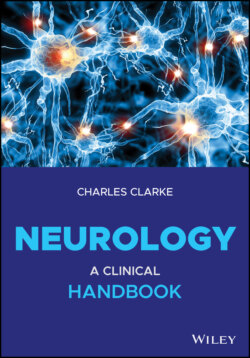Читать книгу Neurology - Charles H. Clarke - Страница 186
Spinothalamic Tracts
ОглавлениеA lesion within these tracts produces changes in pain and temperature sensation below its level. With progressive compression from outside the cord, such as by an enlarging thoracic meningioma (extramedullary cord compression), the sensory level will tend to commence in the feet and rise to the level of the tumour – because of lamination of spinothalamic fibres in the cord. The patient may notice they cannot gauge water temperature with a foot. Extramedullary cord compression tends to affect both principal cord sensory pathways – both posterior column and spinothalamic.
When a lesion is within the cord (intramedullary) such as a syrinx (Chapter 16) sensory loss can initially be confined entirely to the spinothalamic pathways. The sensory loss is described as dissociated. Suspended sensory loss describes another aspect also seen with a syrinx: the dissociated sensory loss does not extend to the lower limbs – it is thus hanging, on the thorax or abdomen.
Sacral sparing is the phrase used to capture preserved sacral and perineal sensation when a central cord lesion expands centrifugally, damaging first centrally placed fibres and reaching last the spinothalamic sacral fibres on the periphery of the cord.
As a cavity develops within one side of the cord, dissociated sensory loss on one side occurs with pyramidal signs such as a spastic lower limb on the other. This carries the eponym Brown‐Séquard, from a treatise in 1849 on traumatic hemisection of cord. Brown‐Séquard findings mean spinothalamic signs on one side with pyramidal and dorsal column signs on the other. They point to a cord lesion, on the same side as the pyramidal and dorsal column loss. The patient may report: ‘I cannot feel the bathwater with my left foot, but it is my right that drags’.
